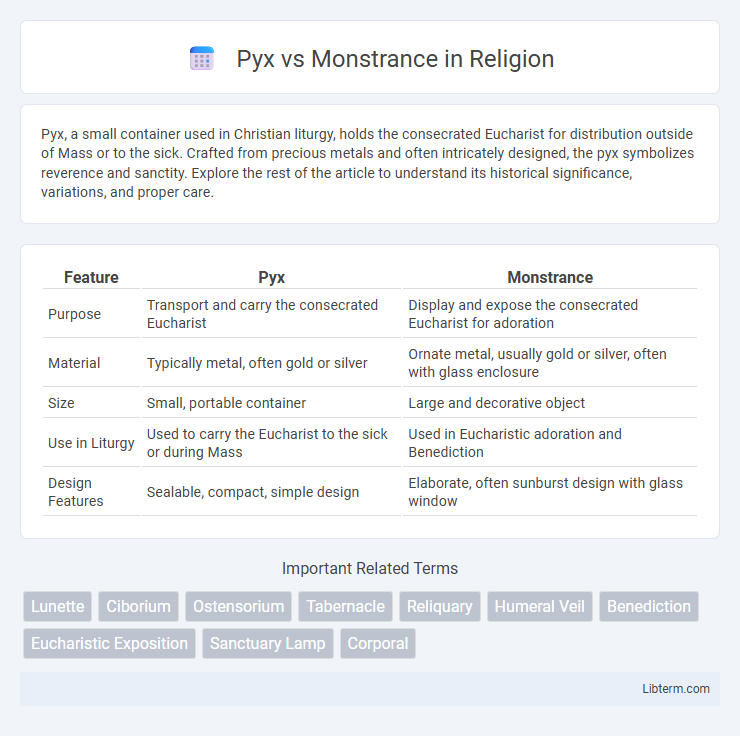Pyx, a small container used in Christian liturgy, holds the consecrated Eucharist for distribution outside of Mass or to the sick. Crafted from precious metals and often intricately designed, the pyx symbolizes reverence and sanctity. Explore the rest of the article to understand its historical significance, variations, and proper care.
Table of Comparison
| Feature | Pyx | Monstrance |
|---|---|---|
| Purpose | Transport and carry the consecrated Eucharist | Display and expose the consecrated Eucharist for adoration |
| Material | Typically metal, often gold or silver | Ornate metal, usually gold or silver, often with glass enclosure |
| Size | Small, portable container | Large and decorative object |
| Use in Liturgy | Used to carry the Eucharist to the sick or during Mass | Used in Eucharistic adoration and Benediction |
| Design Features | Sealable, compact, simple design | Elaborate, often sunburst design with glass window |
Introduction to Pyx and Monstrance
A pyx is a small, usually metal container used in Christian liturgy to carry the consecrated host to the sick or those unable to attend Mass, ensuring the Eucharist remains sacred and protected. A monstrance is an ornate vessel designed to display the consecrated host for adoration during Eucharistic ceremonies, often featuring a sunburst design to emphasize its sacred contents. Both objects serve crucial roles in Catholic worship by facilitating the reverence and transport of the Holy Eucharist.
Historical Origins of the Pyx and Monstrance
The pyx originated in the early Christian church as a small, portable container used to carry the consecrated Eucharist to the sick, reflecting its essential role in pastoral care since antiquity. The monstrance, emerging in the medieval period, was designed to display the consecrated Host during adoration, evolving in ornate form to emphasize visual devotion and liturgical significance in Catholic worship. Both vessels demonstrate the historical development of Eucharistic practices, with the pyx prioritizing function and the monstrance emphasizing ceremonial display.
Purpose and Function: Pyx Explained
A pyx is a small, round vessel designed specifically to carry the consecrated Eucharist to the sick or those unable to attend Mass, ensuring the sacred hosts remain protected and reverently contained. Unlike a monstrance, which is used for displaying the Eucharist during adoration or benediction, the pyx functions primarily for transportation and temporary storage. Its compact, secure design highlights its practical role in pastoral care and sacramental ministry.
Purpose and Function: Monstrance Explained
A monstrance is a sacred vessel used in Christian liturgy to display the consecrated Eucharistic host for adoration, emphasizing its role in public worship and reverence. In contrast, a pyx is a small, portable container designed primarily to carry the Eucharist to the sick or those unable to attend Mass. The monstrance's purpose is to showcase and elevate the Blessed Sacrament during processions or benedictions, highlighting its function as a focal point of devotion.
Key Differences Between Pyx and Monstrance
A pyx is a small, often round container used to carry the consecrated Eucharist to the sick or those unable to attend Mass, designed for portability and secure containment. In contrast, a monstrance is a large, ornate vessel with a transparent center used to display the consecrated host during Eucharistic adoration and benediction, emphasizing visibility and reverence. The primary difference lies in their function: the pyx facilitates discreet transport, whereas the monstrance is intended for public display and worship of the Blessed Sacrament.
Symbolism in Pyx and Monstrance
The Pyx symbolizes the humble containment and safe transport of the consecrated Eucharist, reflecting devotion and reverence in personal or communal worship settings. The Monstrance represents the public display and adoration of the Blessed Sacrament, emphasizing divine presence and sacred visibility during liturgical ceremonies. Both objects hold profound liturgical significance, with the Pyx embodying protection and the Monstrance illustrating glorification of the Eucharist.
Usage in Liturgical and Devotional Practices
A pyx is primarily used to carry the consecrated Eucharist to the sick or those unable to attend Mass, emphasizing portability and protection of the Blessed Sacrament. In contrast, a monstrance is designed to display the consecrated host during Eucharistic adoration and benediction, featuring a transparent central area often surrounded by rays or ornate designs. Both serve distinct liturgical roles: the pyx for distribution and transport, the monstrance for solemn display and worship.
Artistic and Design Variations
Pyx and monstrance exhibit distinct artistic and design variations reflecting their liturgical functions; the pyx is typically a small, round, and simple container made from precious metals, designed for portability and discreetness to carry the Eucharist. In contrast, the monstrance is often an elaborate, large, and ornate vessel featuring sunburst motifs, intricate filigree, and glass panels to prominently display the consecrated host during adoration. These design differences underscore the pyx's utilitarian purpose versus the monstrance's role as a visual focal point in worship.
Care and Handling of Pyx and Monstrance
Proper care and handling of a pyx involve regular cleaning with a soft cloth to maintain its polished surface and storing it in a protective case to prevent scratches. A monstrance requires delicate handling due to its intricate design and usually gold or silver plating, necessitating gentle dusting and careful storage in a padded, secure location to avoid damage. Both sacred vessels should be treated with reverence, ensuring they remain free of tarnish and handled only by authorized personnel during liturgical services.
Contemporary Relevance in the Catholic Church
The pyx and monstrance serve distinct roles in contemporary Catholic worship, with the pyx used primarily for the discreet and practical transport of the Eucharist to the sick or homebound, emphasizing pastoral outreach and accessibility. The monstrance is central to Eucharistic adoration and benediction, visually highlighting the consecrated Host to enhance devotion and community prayer. Both vessels embody the Church's ongoing commitment to reverence, sacramental presence, and the pastoral care of the faithful in modern liturgical practices.
Pyx Infographic

 libterm.com
libterm.com